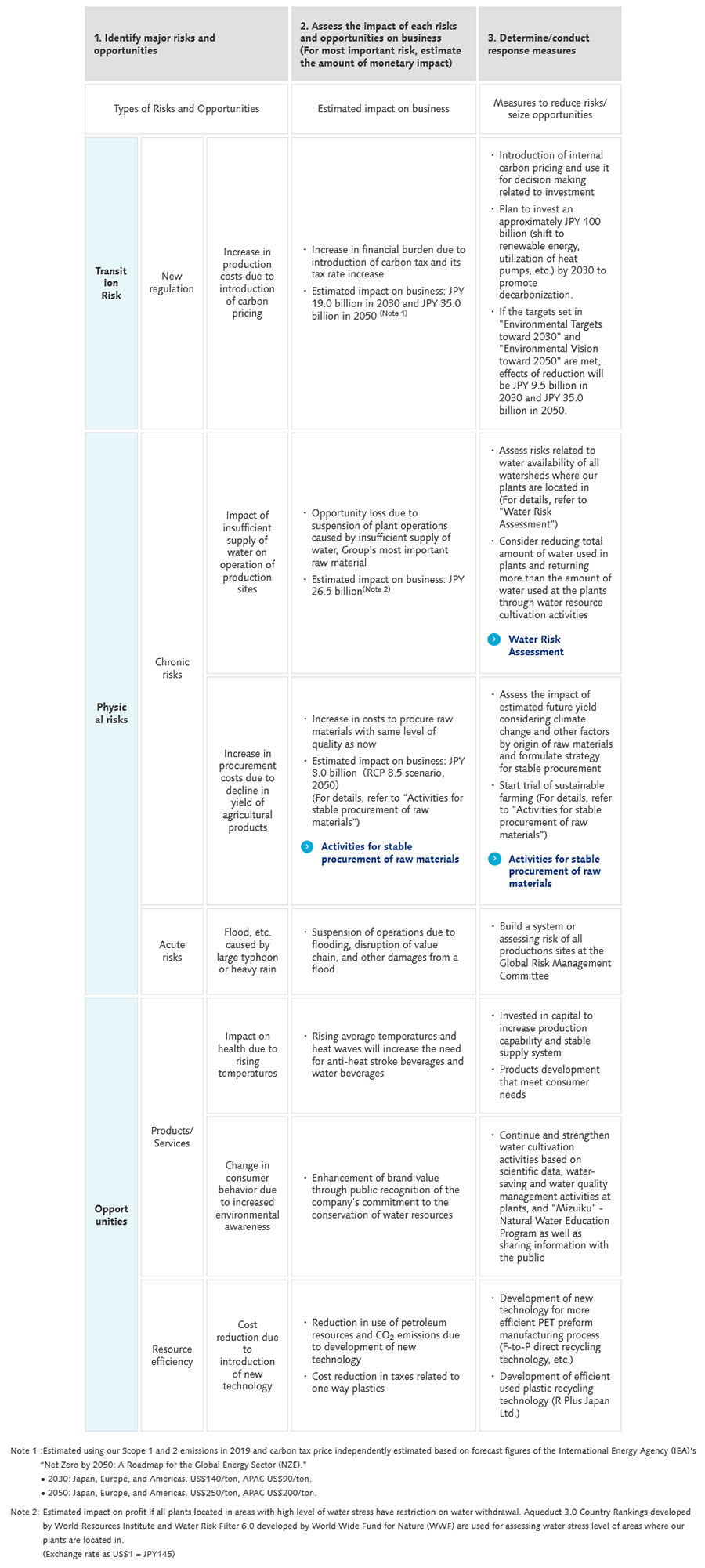Footnote
(Note 1) For the basis of analyzing risks and opportunities, we used RCP 8.5 as global warming scenario and IEA NZE 2050 and other scenarios as decarbonization scenario.
Disclosure Based on TCFD Recommendations
Suntory Holdings Limited
| Updated | May 20, 2024 (Posted on June 3, 2024) |
|---|---|
| Publication date | July 6, 2023 |
| Sector | Industrial and Economic Activities |
Company Overview

The Suntory Group is engaged in an extensive range of business activities including the manufacture and sale of beverages and foods on a global scale. As a multifaceted beverage and food company supported by the blessings of nature, including water and crops, we are dedicated to realize a society where enriching people's lives and conserving the natural environment go hand in hand, and people and nature have a mutually beneficial impact on each other for the long term sustainability of society.
Climate Change Impacts
The Suntory Group believes that it is necessary to identify the risks and impacts of climate change on its business and to respond appropriately in order to sustain its business and continue to create value.
Adaptation Initiatives
In 2019, we declared its support for Task Force on Climate-related Financial Disclosures (TCFD) recommendations. Starting in 2022, in addition to assessing and identifying the risks and opportunities that the problem of climate change presents to society and corporations, we started to estimate the monetary impacts on our business (Fig. 1, Note 1).
Of the identified risks and opportunities, we recognize that (1) increase in costs due to the introduction of carbon tax, (2) opportunity loss due to insufficient supply of water at production sites, and (3) increase in material costs due to decrease in yield of agricultural products are the three items that may have a significantly impact and estimated the amount of their monetary impact on business.
The following is a summary of our efforts to study and implement measures to address these impacts.
(1) Increase in financial burden due to introduction of carbon tax and tax rate increase
- Introduction of internal carbon pricing and use of it for decision making related to investment decisions
- Plan to invest an approximately JPY 100 billion (shift to renewable energy, utilization of heat pumps, etc.) by 2030 to promote decarbonization.
- If the targets set in "Environmental Targets toward 2030" and "Environmental Vision toward 2050" are met, effects of reduction will be JPY 9.5 billion in 2030 and JPY 35.0 billion in 2050
(2) Operational impact of insufficient water supply to production sites
- Assess risks related to water availability of all watersheds where our plants are located in (More details about the water supply risk assessment)
- Consider reducing total amount of water used in plants and returning more than 100% of water used at the plants through water resource cultivation activities
(3) Increase in material costs due to decrease in yield of agricultural products
- Assess the impact of estimated future yields considering climate change and other factors by origin of raw materials and formulate strategy for stable procurement of raw ingredients, and start the trial of sustainable farming (More details about the stable procurement of raw ingredients)
For opportunities, we are expanding product portfolio of beverages with ingredients which are recommended by the Ministry of Environment of Japan as products addressing climate change. We believe that continuing and enhancing water resource cultivation activities, "Mizuiku" - Natural Water Education Program and other activities related to water as well as sharing information about Suntory Group’s approach to water to the public will raise are brand value and lead to increased sales. In terms of resource efficiency, we are actively promoting recycle of plastic bottles.
Effects / Expected Benefits
We aim to resilient by considering both scenarios and taking strategic approach toward the above actualized risks and opportunities, as well as expanding our disclosure of related information.

Fig. 1 Major risks, opportunities, and responses

